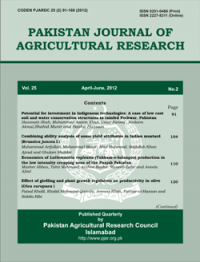EFFECT OF TOPPING UNDER DIFFERENT NITROGEN LEVELS ON EARLINESS AND YIELD OF COTTON
Muhammad Farrukh Saleem*, Munir Ahmad*, Shakeel Ahmad Anjum*, Muhammad Aown Sammar Raza** and Abdul Shakoor*
ABSTRACT
Cotton is perennial plant with indeterminate growth habit. However it has been adopted as annual, so efforts like topping and optimum nitrogen levels to modify its architecture can play a role in improving its success as annual. A field experiment to study the effect of topping under different nitrogen levels on earliness and yield of cotton (Gossypium hirsutum L.) was conducted at Agronomic Research Area, University of Agriculture, Faisalabad, during kharif -1 2013. The crop was sown on ridges on May 24, 2013 using seed rate of 20 kg ha . The experiment was laid out in Randomized Complete Block Design (RCBD) with factorial arrangement having three replications. Treatments included four topping levels: control (no topping), topping at 90 cm, 120 cm and 150 cm height; three -1 nitrogen levels: 150, 200 and 250 kg ha . Net plot size was 6 m × 3 m. Maximum days to first floral bud initiation (44.68), appearance of first flower (65.64), first boll splition (105.47) and monopodial branches per plant (0.81) were recorded at 250 kg -1 N ha . Minimum days for first floral bud initiation (36.66), appearance of first flower (55.97), first boll splition (86.31) and monopodial branches per plant (0.33) were -1 recorded with application of 150 kg N ha . While topping did show non-significant effect on these earliness related parameters. Number of sympodial branches was significantly affected by topping only; with maximum values recorded in no topping closely followed by topping at 150 cm height. Values showed that 90 cm tall plants -1 produced maximum seed cotton yield when supplied with 150 kg N ha ; 120 cm tall -1 plants gave maximum seed cotton with 200 kg N ha while 150 cm tall cotton plants -1 needed 250 kg N ha for highest seed cotton production. In conclusion, cotton growth can be manipulated successfully for better performance by topping provided N dose is monitored.
To share on other social networks, click on any share button. What are these?






